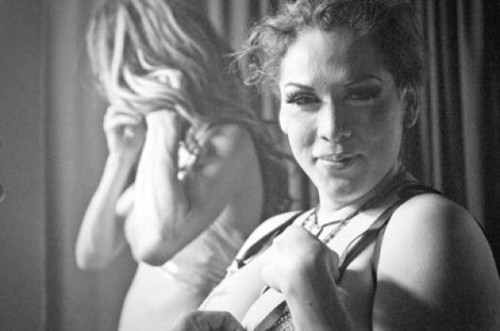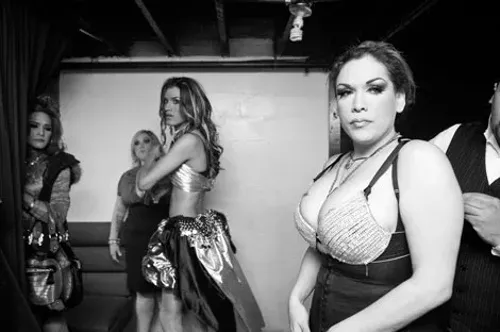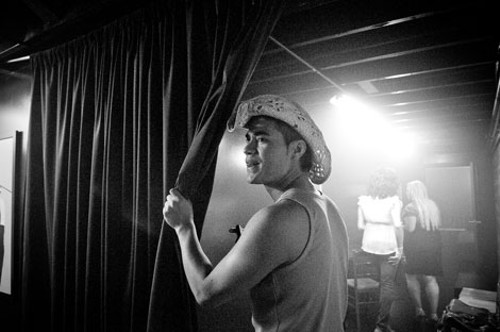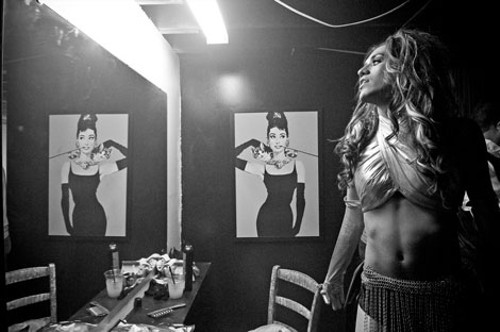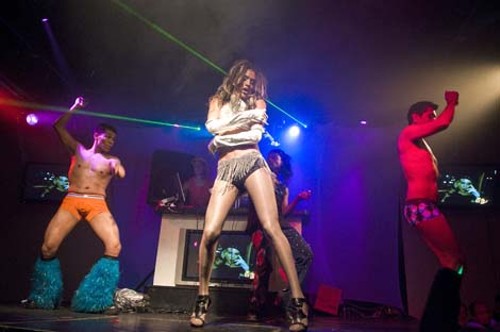King of Queens: Salt Lake's queer, Latino community
Being gay in Utah is hard enough.
By Stephen Dark @stephenpdarkThe brother had been dead for four hours, his nails turning black from pooling blood and his head almost separating from his body when Juan found him at about 10 p.m. on March 25, 2003. Hysterical, he cut the 31 year old down and laid him on the ground. The room was full of fabric that Javier—a brother, but also a transgender woman—had used to make dresses.
For the funeral viewing, Juan, now 40, dressed his brother as a man so as not to offend their Mexican family. “They didn’t want to know or talk about him being HIV positive,” Juan recalls. That denial extended to the two brothers. Juan knew his brother had been diagnosed as HIV-positive two years before his death. “I wanted him to tell me, but he never did. The [Hispanic] culture never teaches you to be open.”
For Javier’s cremation, Juan dressed him as a woman. “I could do that for him.” Javier had recently started taking hormones and had developed breasts. He was growing out his hair, had smooth skin and tattooed his eyelids.
Juan believes his brother was bipolar and killed himself in the midst of a depression. Javier, he says, “wanted to be a woman 100 percent, to have kids, something he knew wasn’t possible in his lifetime. He couldn’t accept that, and it hurt him every day.”
Javier was a pioneer of a popular gay Latino Sunday night at now-closed gay nightclub The Trapp Door. He organized female impersonation shows called Latino Divas that featured drag queens, transvestites and transgender women. Before Latino Divas, attempts by activists to promote HIV prevention had met with failure. Juan, probably Utah’s most experienced gay Latino community activist, used his brother’s Sunday night event to promote HIV awareness.
For almost a decade, Juan, and more recently Utah Department of Health’s HIV outreach coordinator Claudia Gonzalez, have been doggedly handing out condoms at both gay and straight Hispanic bars and clubs. Utah Department of Health HIV Education and Training coordinator Heather Bush says Utah’s 2009 HIV-infection rate of 112 new infections was the highest on record. And while the Hispanic community only comprises 12 percent of the state’s population, 21 percent of men and 21 percent of women with HIV/Aids in 2009 were Latino. “A lot of Hispanic men are bisexual,” Juan says. Married Latino men who have sex with transgender prostitutes they pick up at straight Hispanic dance halls, then take STDs including HIV infections home to unsuspecting spouses are an enormous concern, HIV activists agree.
Interviews over several months with Latino gay men, lesbians, transsexuals and transgender women, some of whom are sex workers saving for their dream of gender-changing surgery, reveal a universe similar to 1970s San Francisco when gays were coming out and attempting to find a supportive community. The Salt Lake City Latino gay scene is similarly decadent and hedonistic. It’s pleasure seeking with a dangerous dark side, however. As gay Latinos open up to the community, many find themselves caught up in unsafe sex, alcohol and drug abuse, and risky plastic surgery. These behaviors are all the more deadly since few are eligible to receive medical care due to their undocumented status.
Lacking government assistance and aid, the community is caring for itself. Juan is helping with his advocacy for safe sex. And if there is a scene for this crowd, 27-year-old gay-night impresario Manuel Arano is hellbent on creating one.
Second Options
One recent Saturday night at Club Edge, dressed in black T-shirt and knee-length pants, Arano, a languid dancer, drifts through the club, engaging briefly in different conversations. Some of his show’s retinue of drag queens and transsexuals hover around him, yet he remains separate, both from them and from the temper tantrums—over, for example, which drag queen will open and close a show—that occasionally erupt in their midst. Atala, a 25-year-old transvestite and frequent performer in Arano’s shows who grew up in Layton, says, as a drag queen, “I used to love to fight, to get drunk.” Other drag queens and transvestites hated him, he says. “They put crushed glass in my compact. All we want to be is stars.”
This is a community riddled with gossip. “I’ve died of AIDS no matter how many times, I’ve committed suicide no matter how many times,” Juan says.
Arano initially succeeded Javier’s Latino Divas with his own “Pachanga Night,” which until the weekend before this year’s Pride festival had been at the Sugar House-based Hispanic nightclub Karamba for 12 months. It was arguably the place to be seen for a community that has only gradually emerged into the neon light, and also the place to learn and verify the day’s gossip.
But “the scene” has just relocated: On the final night of the Utah Pride Festival, Arano launched his new night, “Papichulo” (which means “Cute Guy”), at Club Edge (615 N. 400 West) leaving in his wake aggrieved managers at Karamba and conflicted regulars trying to decide where their allegiances lay. Karamba manager Martin Medina says his club will continue with a Sunday gay Latino night.
Juan worries that the crowd only has eyes for Arano’s gaudy nightclub spectacles, meanwhile ignoring the disturbing health issues that boil beneath.
“Everything Juan did was about the community,” Jennifer Nuttall, the Utah Pride Center adult programs director says. “It’s really hard for him to see the shift” to Arano. She adds there’s no reason why the community, which she says needs leaders, can’t have both men at the forefront.
Juan says his dream is “for the community to come together and care for each other.” That, though, may well be low on the list of priorities, considering all the obstacles gay Latinos can face. Perhaps the largest obstacle is that between 70 and 90 percent of Utah’s gay Latino population, Juan estimates, are undocumented. Lack of papers means no access to Medicaid for mental-health issues, leading many Latino GLBT community members in Utah, traumatized by coming out into an often unyielding and punitive Hispanic culture, whether in the United States or abroad, to find solace in substance abuse rather than seek help.
Alex Moya, the director of the Utah AIDS Foundation’s Hispanic arm, Hermanos de Luna y Sol, argues Latinos are a second or third option when it comes to parceling out resources. “It’s like we’re a second thought,” Moya says. “Everyone talks about being inclusive, diverse, but how do we get there?”
“I don’t think their needs are being met,” Nuttall says. The center, she adds, has hired consultants to help it be more inclusive. Juan points out, however, that the lack of resources may well reflect a greater appetite in the community for partying than, for example, taking courses to become sorely needed medical interpreters. “It’s hard to pull them out of the bars,” he says.
More by Stephen Dark
-
Call it a Comeback
Long mired in economic depression, Midvale’s Main Street dusts off its small-town charm.
- Sep 20, 2017
-
Love Letters
Correspondence between a young woman at the Topaz internment camp and her beloved sheds light on Trump's America.
- Sep 6, 2017
-
Triggered
Veterans Affairs exists to help vets. So why did the Salt Lake VA appoint an anti-veteran chief?
- Aug 30, 2017
- More »
Latest in Cover Story
Readers also liked…
-
Forget the family pedigree—Robert F. Kennedy Jr should not be the next president of the United States
Trojan Horse
- Jun 21, 2023
-
Women decry harassment and toxic culture at St. George auto dealership
Men at Work
- Oct 11, 2023


